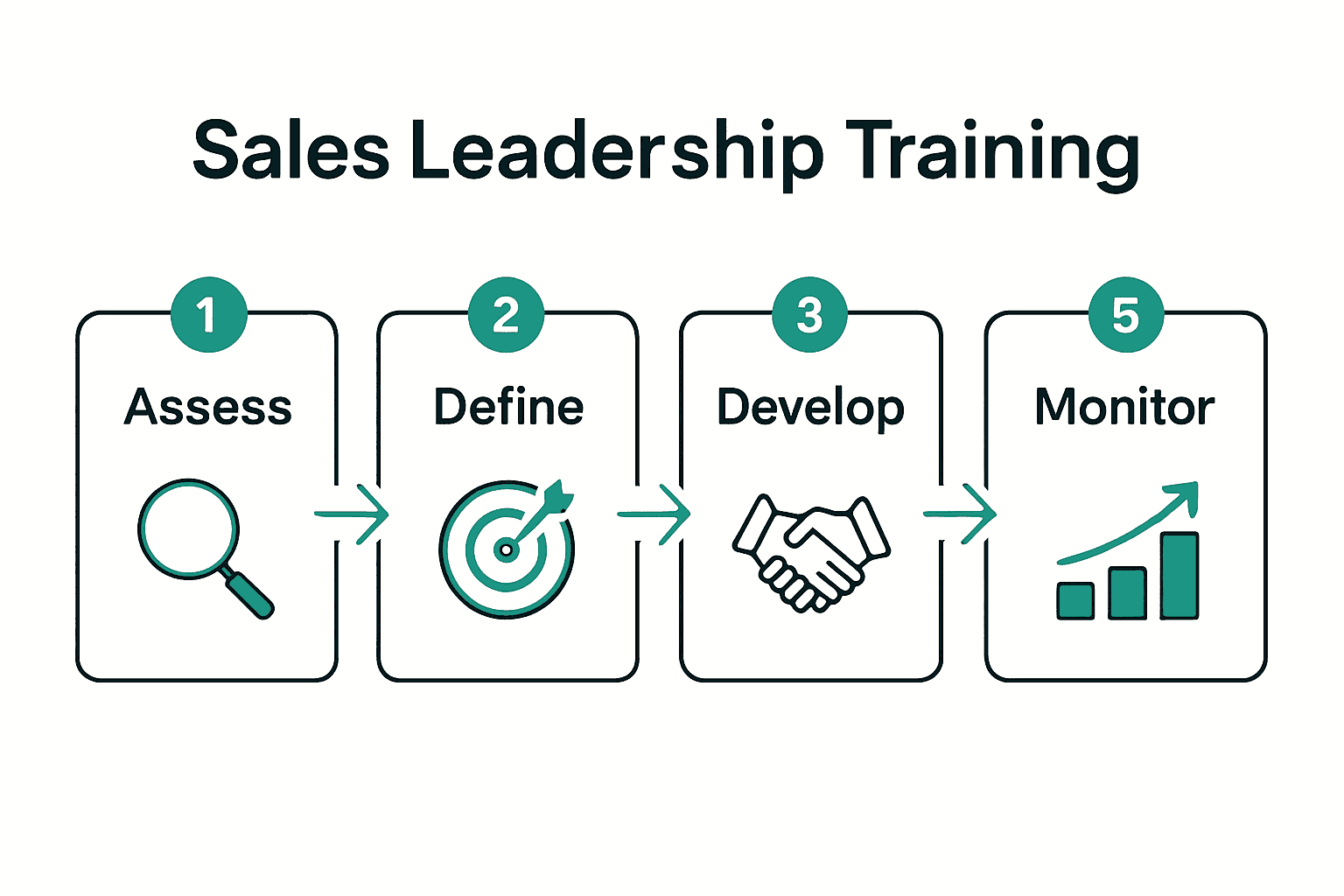Sales Leadership Training Steps for Sustainable Growth
- Digital Sprout
- 11 minutes ago
- 8 min read

Did you know that companies with strong sales leadership can achieve up to 30 percent higher revenue growth than their competitors? Many organisations struggle to identify and address the real issues holding their sales teams back. Understanding and developing effective sales leadership is not just about boosting numbers, but about creating lasting growth, improving team performance, and building a resilient sales culture from the ground up.
Table of Contents
Quick Summary
Key Point | Explanation |
1. Assess sales challenges regularly | Conduct a quarterly review of your sales ecosystem to identify growth obstacles and adapt strategies accordingly. |
2. Define SMART success criteria | Establish clear, specific, measurable, achievable, relevant, and time-bound metrics to guide performance tracking and accountability. |
3. Develop essential leadership skills | Focus on competencies like strategic vision and emotional intelligence to transform sales managers into effective leaders. |
4. Create structured coaching frameworks | Implement systematic coaching systems that support individual and team development through regular feedback and skill-building sessions. |
5. Monitor leadership impact continuously | Establish a dynamic measurement framework to track individual, team, and organizational performance improvements for ongoing enhancement. |
Step 1: Assess Organisational Sales Challenges
This critical first step in sales leadership training involves conducting a comprehensive diagnostic of your current sales ecosystem. By understanding the specific challenges facing your organisation, you can develop targeted strategies for sustainable growth.
To effectively assess organisational sales challenges, start by mapping your entire sales performance landscape. According to UK Civil Service, this means evaluating key performance dimensions including behaviours, strengths, technical skills, and experience across your sales team. You will want to systematically analyse several core areas: pipeline performance, win rates, average deal values, and sales cycle lengths.
Begin with a structured skills and performance assessment. Gather quantitative data like revenue metrics, conversion rates, and pipeline velocity. Then complement this with qualitative insights through team interviews, individual performance reviews, and anonymous surveys. Look for patterns such as inconsistent qualification processes, gaps in sales methodology, or misalignment between sales and marketing strategies. NCFE emphasises the importance of communicating these findings effectively within your organisation to drive meaningful change.
One critical warning: avoid treating this assessment as a one time exercise. Sales environments evolve rapidly, so your diagnostic approach must be iterative and dynamic. Plan to repeat this assessment quarterly to track progress and adapt your strategies.
With a clear understanding of your organisational sales challenges, you are now prepared to move into the next phase of strategic sales leadership training: developing targeted intervention strategies.
Step 2: Define Sales Leadership Success Criteria
Defining clear success criteria is fundamental to creating a robust sales leadership strategy that drives sustainable growth. This step provides a strategic framework for measuring and achieving meaningful performance outcomes across your sales organisation.
According to the Royal College of Surgeons, successful leadership is intrinsically linked to establishing clear goals and desired change. Begin by identifying your primary performance metrics. These might include revenue targets, pipeline conversion rates, average deal size, sales cycle length, and customer retention rates. UK Government Service Manual recommends establishing concrete metrics that can be systematically tracked and evaluated.
Break down your success criteria into three key dimensions: individual performance, team performance, and organisational impact. For individual metrics, consider factors like lead generation capabilities, opportunity qualification skills, and consistent sales methodology adherence. Team metrics should evaluate collective performance through collaborative indicators such as cross functional alignment, knowledge sharing, and team win rates. At the organisational level, focus on broader outcomes like revenue growth, market penetration, and strategic goal achievement.
Pro Tip: Ensure your success criteria are SMART specific, measurable, achievable, relevant, and time bound to maintain clarity and accountability.
Remember that success criteria are not static documents. Plan to review and recalibrate these metrics quarterly to reflect evolving market conditions and organisational strategies. Sales Leadership Training Framework for Predictable Growth can provide additional insights into creating adaptive performance measurement systems.
With your success criteria clearly defined, you are now prepared to move into the next critical phase of sales leadership development: designing targeted training and coaching interventions.
Step 3: Develop Practical Leadership Capabilities
Developing practical leadership capabilities is crucial for transforming sales managers into strategic leaders who can drive team performance and organisational growth. This step focuses on building the essential skills and mindsets that distinguish exceptional sales leaders from average managers.
According to the Senior Leadership National Professional Qualification, effective leadership development requires a comprehensive approach to strategic thinking and team management. Start by identifying your core leadership competencies through a structured self assessment. The UK Government Success Profiles recommends evaluating key strengths such as adaptability, analytical thinking, and resilience as foundational leadership capabilities.
Focus on developing four critical leadership dimensions: strategic vision, emotional intelligence, coaching capabilities, and performance management. For strategic vision, practice creating clear roadmaps that align team objectives with organisational goals. Enhance emotional intelligence by improving communication skills, learning to read team dynamics, and developing empathy. Build coaching capabilities through active listening, providing constructive feedback, and creating personalised development plans. In performance management, learn to set clear expectations, track meaningful metrics, and provide timely, actionable guidance. Strengthen Leadership with Targeted Sales Coaching Now offers additional insights into refining these critical leadership skills.
Pro Tip: Leadership development is a continuous journey. Commit to regular self reflection, seek feedback, and invest in ongoing learning opportunities.
By systematically developing these practical leadership capabilities, you are creating a robust foundation for sustainable sales team performance and organisational growth. Your next step will involve implementing targeted training and coaching interventions to embed these newly acquired leadership skills across your sales organisation.
Step 4: Implement Team Coaching and Support Systems
Implementing robust coaching and support systems is critical for transforming individual sales performers into a high performing, cohesive sales team. This step focuses on creating structured frameworks that enable continuous learning, accountability, and personal development across your entire sales organisation.
The Civil Service Success Profiles emphasise the importance of team leadership and relationship building as fundamental components of effective coaching systems. Begin by establishing a comprehensive coaching framework that includes regular one to one meetings, performance reviews, skill development sessions, and peer learning opportunities. Civil Service Leadership Statement highlights that successful leaders must actively support and develop their teams to achieve organisational goals.
Design your coaching system around three core pillars: individual skill development, collaborative team learning, and performance management. For individual development, create personalised coaching plans that address specific skill gaps and career aspirations. Implement team learning through structured knowledge sharing sessions, role playing exercises, and collaborative problem solving workshops.

Establish a performance management approach that combines objective metrics tracking with qualitative feedback and continuous improvement goals. Building a Consistent Sales Coaching Programme for Teams provides additional insights into creating a comprehensive coaching strategy.
Pro Tip: Consistency is key. Ensure your coaching system is predictable, transparent, and aligned with both individual and organisational objectives.
By implementing these systematic coaching and support mechanisms, you are creating an environment that nurtures talent, drives performance, and builds a resilient sales culture. Your next step involves monitoring and refining these systems to ensure ongoing effectiveness and adaptation.
Step 5: Monitor and Measure Sales Leadership Impact
Monitoring and measuring sales leadership impact is crucial for understanding the effectiveness of your training and coaching interventions. This step involves creating a systematic approach to tracking performance improvements and identifying areas for continuous development across your sales organisation.
According to the UK Government Service Manual, defining success and publishing performance data are fundamental to measuring leadership impact. Begin by establishing a comprehensive measurement framework that captures both quantitative and qualitative indicators. NCFE Level 5 NVQ Diploma recommends evaluating multiple sources of customer performance data and employing advanced analytical techniques to identify meaningful patterns and trends.
Develop a multi dimensional measurement approach that includes key performance indicators across three critical areas: individual performance, team effectiveness, and organisational impact. For individual metrics, track sales productivity, skill progression, and coaching engagement levels. Team effectiveness metrics should encompass win rates, pipeline quality, and collaborative performance. Organisational impact measures might include revenue growth, customer satisfaction, and long term strategic alignment. Key Metrics Measuring Sales Coaching Success Impact provides additional insights into selecting and tracking these critical performance indicators.
Pro Tip: Create a dynamic dashboard that provides real time visibility into your leadership impact metrics, enabling quick adjustments and continuous improvement.
By systematically monitoring and measuring your sales leadership impact, you create a feedback loop that drives ongoing performance enhancement. Your final step will involve adapting and refining your approach based on these insights to ensure sustained growth and development.
Transform Your Sales Leadership Challenges into Sustainable Growth
If your sales organisation struggles with inconsistent pipeline, low win rates, or long sales cycles as highlighted in “Sales Leadership Training Steps for Sustainable Growth,” it is clear these problems are systemic, not just isolated issues. This article outlines vital concepts like assessing sales challenges, defining clear success criteria, and embedding practical leadership capabilities that resonate deeply with the need for a strategic, ongoing approach rather than one-off fixes.
At The Sales Coach Network, we specialise in partnering with senior revenue leaders grappling with these exact pain points. Unlike traditional sales training providers, we deliver a proven framework that focuses on real-world results by embedding scalable sales operating systems that increase qualified pipeline, boost average deal size, and enhance team performance. Our comprehensive sales leadership training and sales coaching services are designed to help organisations like yours break through growth plateaus with sustainable, measurable improvements.
Ready to move beyond transient solutions and start driving predictable, scalable growth? Discover how our expert practitioners act as trusted partners to help you adapt your strategy, accelerate sales velocity, and achieve lasting success by visiting The Sales Coach Network today.
Frequently Asked Questions
What are the first steps in sales leadership training for sustainable growth?
Start by assessing your organisational sales challenges through a comprehensive diagnostic of your sales ecosystem. Map out key performance areas such as pipeline performance and win rates, and gather both quantitative and qualitative data to identify specific gaps and opportunities for improvement.
How can I define success criteria for my sales leadership training?
Define success criteria by identifying key performance metrics like revenue growth and sales cycle length. Break these down into individual, team, and organisational metrics, and ensure these goals are SMART—specific, measurable, achievable, relevant, and time-bound.
What practical leadership capabilities should I develop in my sales team?
Focus on enhancing four critical dimensions: strategic vision, emotional intelligence, coaching skills, and performance management. Set clear expectations, actively listen to team concerns, and align team objectives with broader organisational goals for effective leadership.
How do I implement coaching and support systems for my sales team?
Establish a structured coaching framework that includes regular one-on-one meetings and skill development sessions. Design personalized coaching plans to address individual skill gaps while fostering a culture of continuous learning through team workshops and peer collaboration.
How can I monitor and measure the impact of my sales leadership training?
Create a measurement framework that includes both quantitative and qualitative performance indicators across individual, team, and organisational levels. Regularly track metrics like sales productivity and customer satisfaction to identify patterns and drive continuous improvement.
How often should I assess my sales leadership training outcomes?
Plan to assess your sales leadership training outcomes quarterly to stay aligned with evolving market conditions and organisational strategies. Regular assessments help you refine your approach and ensure sustained growth in your sales performance.

Recommended